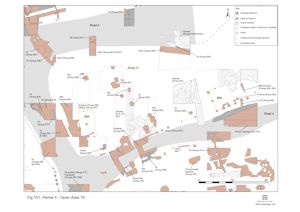
The investigated east and western ends of OA19 are separated by unexplored and poorly understood areas of the site (i.e. between Excavation Areas H and M). Like the western end, a new building is established in the eastern part, perhaps accompanied by sub-enclosures or pens to its south (Figure 151). This may indicate that the previously maintained open space is now given over to a different, possibly occupational, use.


A series of posts (Group 467) form two sides of an abbreviated rectilinear building, consisting of a central aisle leading off a south-facing porch, and a room either side (Figure 170). The west side is much more convincing than the east, or even the aisle. The posts of the west wall are all between 2.25 and 2.5m apart, and the walls are aligned NNW-SSE and extend at least 7.5m. The south frontage could be 8m either side of the 2.7m-wide aisle, for a total width of 18.7m, of which 16m is traceable. If post-hole 15215 (Group 6010) is included, the aisle might run at least 8.5m back from the frontage.
The aisle wall foundations consist of smaller and less regular posts than the west room. It seems likely that the east wall of the west room is real and has simply suffered more disturbance than the west. However, the posts of the opposite walls of this room do not stand in neatly aligned pairs. This suggests that the aisle posts must be supporting internal walls only, and the exterior posts support the roof. Most of the pottery from the fills of the post-holes dates to the mid-2nd to mid-3rd centuries. The coin provides a mid-2nd century date. The fills also often include small amounts of building materials and bone, and a single piece of strip lead. All of these materials, especially when occurring in post-hole fills, tend to be more common in the later Roman periods than the earlier.
It is unlikely that any more posts remain unrecorded within the excavated area, but the building may extend further north. Any continuation of the west exterior wall will be truncated by pit 15227 (Group 468) and then pass beyond the edge of excavation, while the east wall of the aisle might be undetected in the fills of ditch 15045 (Group 410 Period 3). It should be noted that many recorded posts in the vicinity remain unassigned and uninterpreted, and other building plans may be possible.
The suggested reconstruction of the building comprises a west room some 8.2m wide by anything from 8.4m to 16m long, opening off a corridor or aisle to its east, 2.7m wide by at least 8.4m long, aligned NNW-SSE, leading from a porch that extends for another 1.5m to the south. The eastern room is far less certain, but it might be at least 5.2m wide and is probably symmetrical with the western room, some 8m wide. Its extent northwards is unknown.
Just south of Building 57, it is possible to pick out other arrangements of parallel lines of posts. For example, 15177, 15165, 15169, 15134, 15211, 15208, 15217, 15200 may form a rectangle 7.5m by 9.25m, but its alignment, due north-to-south, does not fit with anything else on site, and, does not account for all the posts. The south side of this rectangle would be truncated by ditch 25078, and it cannot possess a north side.
In the eastern part of OA19 (Excavation Area M), only a single mid-Roman pit, 15227/15271 (Group 468) is excavated. As well as relatively large quantities of pottery tile and animal bone, it contains three coins (SFs 5936-8), a copper-alloy brooch fragment (SF5948), a bone needle (SF5449) and a small amount of septaria. Notably, its two fills each include a single human bone.
Internet Archaeology is an open access journal based in the Department of Archaeology, University of York. Except where otherwise noted, content from this work may be used under the terms of the Creative Commons Attribution 3.0 (CC BY) Unported licence, which permits unrestricted use, distribution, and reproduction in any medium, provided that attribution to the author(s), the title of the work, the Internet Archaeology journal and the relevant URL/DOI are given.
Terms and Conditions | Legal Statements | Privacy Policy | Cookies Policy | Citing Internet Archaeology
Internet Archaeology content is preserved for the long term with the Archaeology Data Service. Help sustain and support open access publication by donating to our Open Access Archaeology Fund.